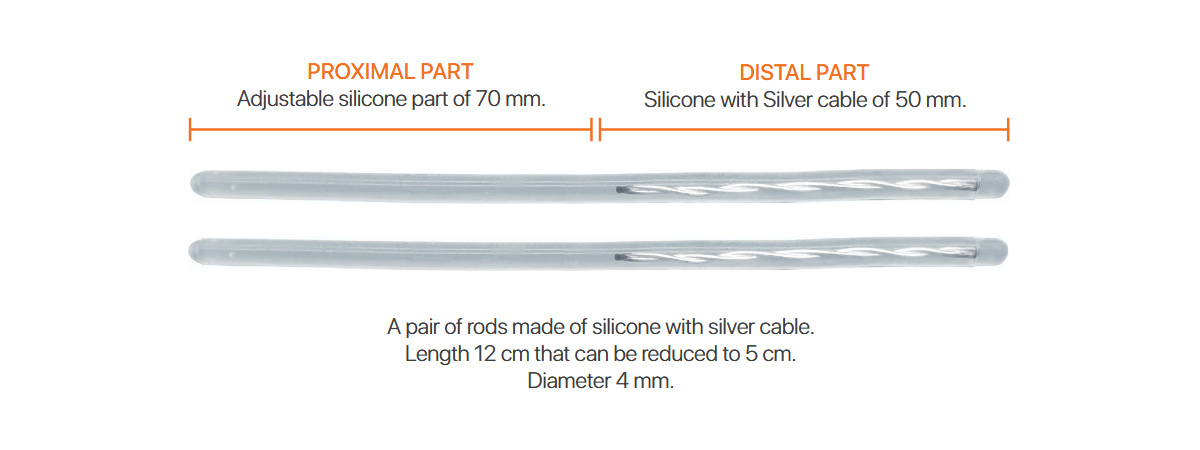ZSI 100 D4 Semirigid Implant for Metoidioplasty
The ZSI 100 D4, made by Zephyr Surgical Implants, is a specially designed semirigid penile prosthesis created for patients undergoing metoidioplasty. It's implanted inside the hormonally enlarged clitoral tissue (corpus cavernosum) to provide rigidity and support, helping to maintain length and improve the ability to urinate while standing. Unlike implants designed for sexual penetration, this prosthesis primarily offers structural support and aesthetic enhancement. It's not intended to assist with penetrative intercourse.

As of now, the ZSI 100 D4 isn't available in the United States and has only been implanted in a limited number of centers in France, Italy, and Colombia. While early results are promising, this remains an emerging technique in gender-affirming care. Patients in other countries may be able to access the procedure through medical tourism, but this involves additional costs, planning and risks.
 How Implant Surgery Is Done
How Implant Surgery Is Done
During metoidioplasty surgery, the surgeon releases the clitoral tissue and reconstructs the urethra using vaginal mucosa and flaps from the labia minora. After preparing the corpora cavernosa, the ZSI 100 D4 implant is inserted to stiffen the neophallus and preserve the length gained from hormone therapy and surgery. The prosthesis can be trimmed to fit the desired length, although the actual length achievable depends on clitoral growth resulting from testosterone therapy, as the implant doesn't provide additional length on its own.
The surgery typically lasts about 4 to 5 hours and involves releasing the clitoral bodies, reconstructing the urethra, and placing the implant. Scrotoplasty (creation of a scrotum) is done in a second procedure, a few months later, to allow healing.
After surgery, patients usually stay in the hospital for 3 to 5 days with urinary catheters (urethral and suprapubic) in place. These catheters are removed gradually once healing is confirmed and there are no complications such as fistulas.
Watch a video of implantation of the ZSI 100 D4 device. Please note: The video contains graphic surgical content. Sign in required.
- Operative Technique Overview: Watch Video
Who Might Benefit from the ZSI 100 D4 Implant?
- People seeking increased rigidity and length: For those who want more structural support of the neophallus beyond what natural erectile tissue provides.
- People who want to improve urination while standing: The implant helps create a straighter urinary stream, making standing urination easier and more reliable.
- People interested in aesthetic enhancement of the neophallus.
Special Consideration: Use After Deep Tissue Mobilization Procedures
Procedures like Extensive Metoidioplasty or Tunica-Cavernosum Mobilization (TCM) involve significant dissection and mobilization of the erectile tissue to maximize length and neophallus size. However, this can sometimes lead to reduced erectile capacity or instability, meaning the natural ability to achieve or maintain rigidity may be compromised.
While the ZSI 100 D4 implant doesn't aim to restore natural erectile function or spontaneous erections, it may offer a valuable alternative for patients experiencing these challenges. This could represent an important opportunity for collaboration between patients, surgeons, and researchers. Secondary use of the implant in this context may open a new frontier in optimizing functional outcomes for those who have undergone length-maximizing techniques.
Secondary Implantation After Prior Metoidioplasty
In addition to its use during primary surgery, the ZSI 100 D4 may also have potential in patients who previously underwent metoidioplasty but later experienced reduced erectile function or loss of length. The information from both Zephyr Surgical Implants and published studies describe implantation of the ZSI 100 D4 during the initial metoidioplasty procedure, with no specific mention of implantation in patients who have previously undergone metoidioplasty without a prosthesis. However, based on the implant’s design and the established surgical principles for prosthesis insertion, secondary implantation in patients with a prior metoidioplasty could be possible. This approach might offer a solution for those seeking enhanced rigidity after their initial surgery. Further studies are necessary to assess the safety, feasibility, and functional outcomes in this context.
What Are the Risks and Complications?
Like any surgery, metoidioplasty with implantation carries some risks, especially around urethral reconstruction. However, in the studies reviewed, the complications reported were associated with the metoidioplasty portion of the procedure, not with the implant itself. Importantly, there were no infections, erosions, or mechanical failures of the ZSI 100 D4 prosthesis during an average follow-up of 22 months.
While long-term data is still limited, these early results are encouraging. In follow-up surveys, most patients reported being satisfied or very satisfied with both the appearance and function of their genitalia. The majority were able to urinate while standing and expressed low levels of regret about undergoing the procedure.
The ZSI 100 D4 semirigid implant represents a potentially valuable option to enhance metoidioplasty outcomes by preserving length, adding rigidity, and improving urinary function. While its use is primarily described in conjunction with primary metoidioplasty, its potential role as a secondary implant for patients who have already undergone Extensive Metoidioplasty or Tunica-Cavernosum Mobilization (TCM) represents an area of growing interest. In cases where natural erectile capacity is reduced or unstable after such procedures, the implant may offer meaningful functional and aesthetic benefits, though further clinical experience and research are needed.
If you're considering getting the ZSI 100 D4 implant, consult with an experienced reconstructive urologist to discuss your goals, expectations, and whether the implant is right for you.
References
- Zephyr Surgical Implants. (n.d.). Procedure manual: Malleable implant for metoidioplasty [PDF]. Retrieved June 2025.
- Monchablon, B., Morel-Journel, N., Carnicelli, D., Jurek, L., Ruffion, A., & Neuville, P. (2023). Surgical outcomes, motivations, sexuality, and urinary function of metoidioplasty with semi-rigid prosthesis. International Journal of Transgender Health, 26(1), 63–72. https://doi.org/10.1080/26895269.2023.2279273
- Paul Neuville, Damien Carnicelli, Philippe Paparel, Alain Ruffion, Nicolas Morel-Journel. Metoidioplasty with Implantation of a Specific Semirigid Prosthesis, The Journal of Sexual Medicine, Volume 18, Issue 4, April 2021, Pages 830–836, https://doi.org/10.1016/j.jsxm.2021.01.177
Last updated: 06/01/25